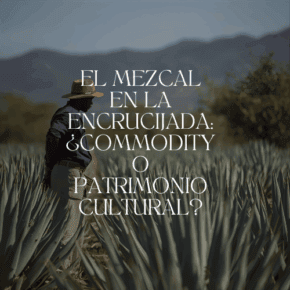Mezcal exploded into the mainstream in 2022. Success raises questions and expectations.
Like many of us, I am scratching my head at the fact that 2022 has come to an end. I have no idea where the year went but events are back, bars and restaurants are packed, and the world is moving forward. While the pandemic never ended, it seems like most people have decided to live as if it is in the rear view mirror. No one shared that perspective with the supply chain which continues to suffer from shortages and delays while rapid inflation has been a huge issue. So what does all of this mean for the world of mezcal?
Well, for one thing, demand for mezcal skyrocketed. According to Shanken News,
“Globally, Mezcal shipments surpassed one million 9-liter cases last year for the first time ever, after a 23% gain over 2020, according to Impact Databank. The U.S. remains the largest market for Mezcal—ahead of the home market of Mexico—and now represents over half of the global category. Last year’s volume in the U.S. was a three-fold increase compared to just four years prior. The pace had slowed to a modest 12.5% in 2020 due to the pandemic’s crippling effect on the on-premise sector, but the former trajectory has now resumed, and only spirits-based RTDs are currently growing faster than Mezcal.”
And forecasts do not see demand slowing: Mezcal is projected to be a billion dollar industry by 2025. We wouldn’t be surprised to see it happen sooner than that unless there is some threat to agave or a recession.
The agave dilemma
There has been a massive investment in the cultivation of agave, mostly in Oaxaca but also in Puebla. Spend time driving through the Valles Centrales and south from Matatlan toward the Istmo in Oaxaca and all you will see are fields of agave. This demonstrates great planning for future demand, but it is a slow building environmental issue. Hills are deforested, leading to erosion and soil degradation. The greater focus on mono cultivation impacts biodiversity while also diminishing traditional farming practices like the Milpa.
Then there is the question of who has access to agave. In areas governed by ejidos, or community property, there can be competition among makers of who gets access to the agaves. Sometimes small producers are priced out, as we heard in Puebla. The higher the price, the more difficult it becomes for a mezcalero to pass on those costs to a local market which cannot afford to buy mezcal priced above 500 pesos a liter. The demand for agave has even on occasion meant mezcal could cost as much as 1,000 pesos a liter for small production runs. One family even told us that they would have to stop producing mezcal until the cost of agave came down or they found a different source.
In other areas, like Sonora and Durango, the agave issue is that there isn’t enough. Gilberto Roldan, a mezcalero in Durango, told me that they are about 10 years behind Oaxaca when it comes to agave cultivation. Unless you are able to plant your own agave – like Origen Raiz, Cuero Viejo, and Clase Azul you are forced to compete for agaves on the open market. Rising prices squeeze out some makers while creating pressure on growers. Cenizo takes 12 years to grow, though vivero projects are showing it can be done in 10, so the variables are very difficult to manage. Several mezcaleros are also participating in the Sembrando Vida program but given that cultivation projects are just ramping up, we could see shortages over the next five to seven years.
In Sonora it is a similar story as I wrote about after my trip there. The impacts of the deep freeze that hit northern Sonora and wiped out the agave are still being felt. There are some vivero projects being implemented, but they are still young, and it is possible that demand for Bacanora could exceed availability.
When it comes to wild agaves, we should see the impact of some of the semi cultivation projects over the next couple of years. Some of these projects are showing reduced growing times because starts have spent their crucial first couple of years in protected environments. This could slow the deforestation crisis.
So yes, growing agave is crucial for the long term sustainability of agave spirits, but how it is being grown will be the crucial issue going forward.
Does this mean greater industrialization?
Obviously businesses will see opportunities to either get into the world of mezcal if they aren’t already there, and/or build a brand with a total focus on the bottom line. This has happened already and I think it is imperative that we recognize that the mezcal category is a business and always has been a business.
I’ve been hearing from different sources that when it comes time to update NOM 70, there are parties interested in creating a new category for mixtos, much like in tequila. My first reaction to this was ‘oh god no!’ but as I thought about it more and more, maybe it is not such a bad idea.
If you believe the rumors, which I do, there are already mezcals on the market that are not 100% agave. This would be a way to force greater transparency about what is happening and to let the consumers decide if that is something they want to drink. It also might open the door to a very real conversation about the Denominacion de Origen – is it solely a marketing mechanism or a guardian of tradition?
It does seem like we are at an inflection point, though folks like Asis Cortes insist that we hit that point a few years back. The problem is that mainstream success means pricing pressure and that increases pressure to industrialize which may reduce the craft identity that consumers love. The irony here is obvious. It opens the door to the image washing that other categories have successfully managed.
Where does this leave the small guys?
How do you access a market that, in the complexity of the three or four tier structure, makes it difficult for independent or small brands? Navigating all the regulatory barriers would seem to favor larger companies with larger sales and legal teams. Generally speaking, large distributors also have a leg up because they carry so many high margin spirits like vodka and common mixers which can help offset lower margin spirits like mezcal. And large distributors are less likely to pick up products for their portfolios if they are small volume brands.
But here’s the interesting thing, consumers are interested in buying small brands, especially if they are family or producer owned. The stories that these brands can tell through social media reach directly into the psyche of the US consumer. And, many of the sales outlets for mezcal are staffed by people who have a personal investment in brand stories. They’ve tasted the smaller production bottles and have heard the stories from brand reps. Sometimes they have even met producers. They bring these relationships directly to their customers.
This is especially important in understanding e-commerce and alcohol. Small but focused retailers can now go over the top of traditional sales channels and offer an amazing breadth of small production mezcals to consumers in most of the US. Madre Restaurants launched its store in August, 2022 with an explicit focus on traditional producers. Long time stalwart Old Town Tequila has been doing this for years and Tahona Mercado has expanded its offerings.
Small brands with a focused strategy can now distribute in one state, work with retailers like Old Town and quickly ship to more than 20 states. For small, producer-owned brands, this could help bypass the miasma of the three tier system and the complexity of working with multiple distributors across multiple states.
The case for consumer education
All the way back in 2013 we wrote about the commodification of mezcal. While some of those fears have been realized, there is still a market for small, traditionally produced, mezcal. That exists because of consumer education. The breadth of mezcal available in the US market is astonishing. The fact that so much of it is good is testimony to the hard work people have put in over the years to educate consumers about what they are drinking. It works and it has enabled a market that includes high volume commercialized mezcal and brands that have expressions of less than 100 liters in their line-up, plus everything in between.
2022 was an intense year. Between events and visiting mezcal production regions across Mexico, we spent a great deal of time on the road. There were a few things we saw that made us seriously question what was happening in the category and how we could continue forward in a meaningful way. But then we had some truly spectacular experiences and met people along the way doing innovative things that made us realize how crucial it is to get these stories out to the public. Who else is covering this in a significant way?
In 2023 we will be pushing harder to get more information out into the market through more brand profiles and our continued focus on the issues that continue to impact the category. We are excited by the opportunities to share that information with a new and growing audience for mezcal.












Leave a Comment